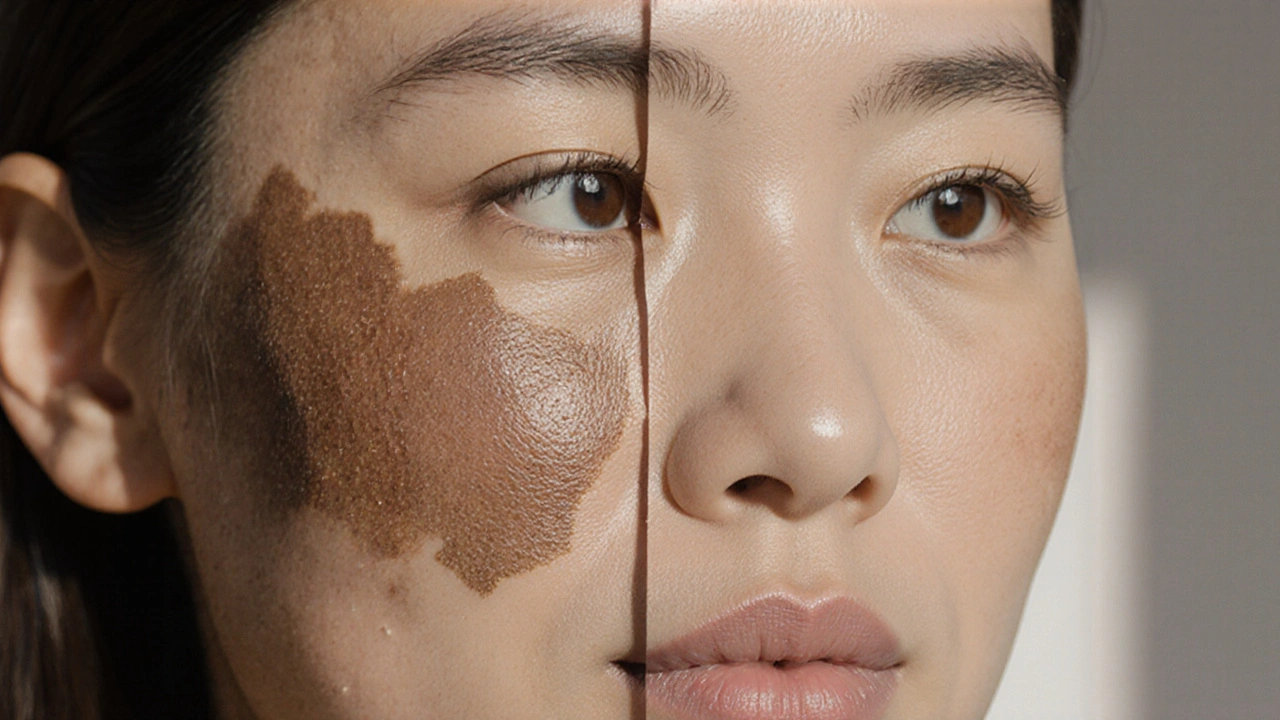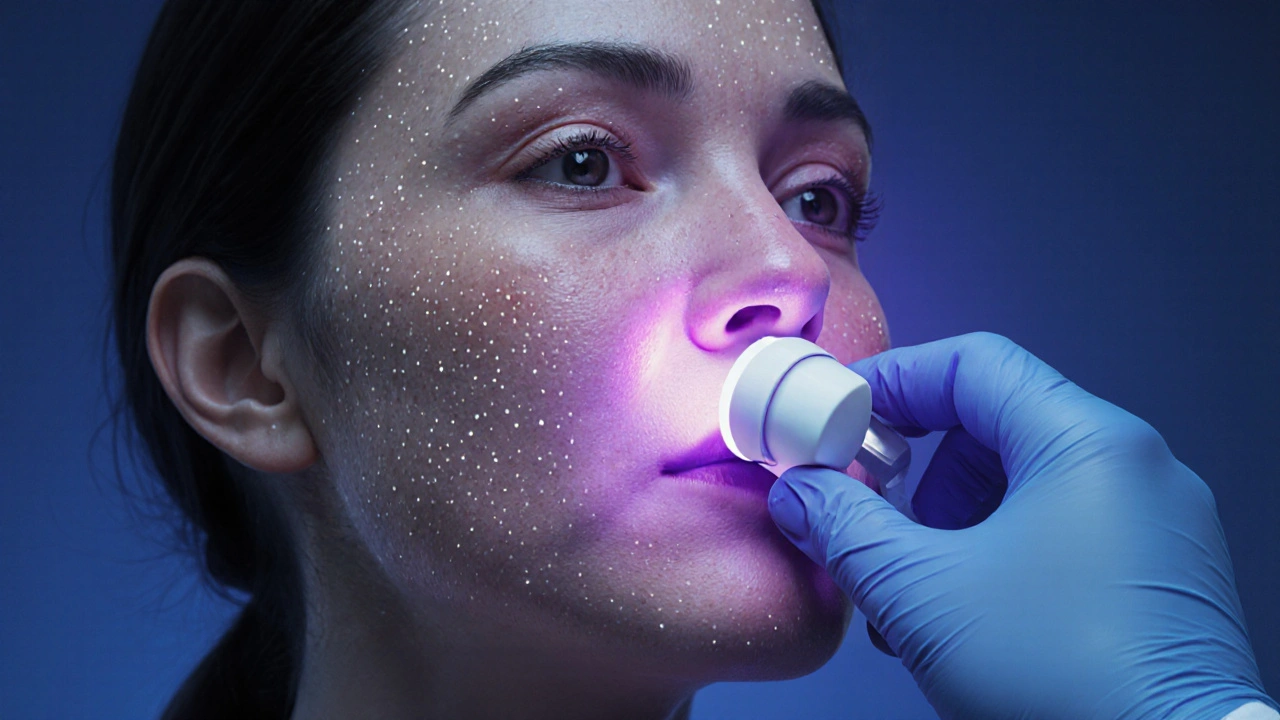Melasma vs Hyperpigmentation: Key Differences Explained
 Oct, 5 2025
Oct, 5 2025
Melasma vs Hyperpigmentation Quiz
Test your understanding of melasma and hyperpigmentation differences. Select the best answer for each question!
Melasma
Symmetrical facial pigmentation often triggered by hormones.
Hyperpigmentation
Irregular, varied causes including acne scars and sun damage.
Quick Takeaways
- Melasma is hormonally driven, often symmetrical on the face, while hyperpigmentation covers a broader range of causes and patterns.
- Both conditions worsen with UV exposure, so diligent sun protection is non‑negotiable.
- Topical agents like hydroquinone work for many cases, but laser or chemical peel options differ between the two.
- Accurate diagnosis by a dermatologist guides the most effective treatment plan.
- Consistent skincare routine and lifestyle tweaks can keep spots from returning.
Ever looked in the mirror and wondered why those brown patches seem stubbornly different? You’re not alone. Melasma and hyperpigmentation are often tossed together, but they’re actually two distinct skin issues with their own causes, patterns, and treatment playbooks. This guide breaks down the science, tells you what to watch for, and gives you a straightforward roadmap to clearer skin.
What Is Melasma?
Melasma is a chronic skin condition characterized by dark, irregular patches typically appearing on the cheeks, nose, forehead, and upper lip. It tends to be symmetrical, meaning both sides of the face often mirror each other. While anyone can develop melasma, it’s most common in women of reproductive age, especially those with darker Fitzpatrick skin types (III-VI). Hormonal shifts-like pregnancy, oral contraceptives, or thyroid disorders-are the primary trigger, making melasma a hormonally driven pigment disorder.
What Is Hyperpigmentation?
Hyperpigmentation is an umbrella term for any darkening of the skin caused by excess melanin production. Unlike melasma, hyperpigmentation can result from a wide array of factors: post‑inflammatory marks (acne scars, cuts), sun‑induced spots (solar lentigines), medication side effects, or even certain cosmetics. The patches are usually irregular in shape and distribution, and they can appear anywhere on the body-not just the face.
Key Differences at a Glance
| Attribute | Melasma | Hyperpigmentation |
|---|---|---|
| Primary Cause | Hormonal changes (pregnancy, OCPs) | Various: UV exposure, inflammation, medication |
| Typical Pattern | Symmetrical, facial‑centric | Irregular, can affect any body part |
| Common Locations | Cheeks, forehead, upper lip, nose | Face, hands, arms, shoulders, knees |
| Age Group | 20‑40 years, women predominance | All ages, both genders |
| First‑Line Treatments | Topical hydroquinone, azelaic acid, sun protection | Varies: hydroquinone, retinoids, chemical peels, lasers |
Common Triggers That Fuel Both Conditions
Even though melasma and hyperpigmentation have different root causes, a few culprits overlap:
- UV Radiation - Sunlight accelerates melanin production for any pigment issue.
- Hormonal Changes - While central to melasma, they can also exacerbate post‑inflammatory hyperpigmentation.
- Skin‑Care Products - Harsh exfoliants or fragrance‑laden creams may irritate the barrier, prompting inflammation‑driven spots.
- Heat and humidity - Trigger excess melanin synthesis in susceptible skin.

How Dermatologists Diagnose the Difference
Spotting the visual clues is the first step, but a professional exam often involves:
- Wood’s lamp examination - Highlights pigment depth and distribution.
- Dermoscopic analysis - Shows vascular patterns more typical of melasma.
- Patient history - Hormonal factors, recent injuries, medication use.
If you notice new, symmetric brown patches and you’re on hormonal medication, it’s likely melasma. If the spots follow a healed pimple or are uneven across the forearms, hyperpigmentation is the more probable culprit.
Targeted Treatment Options
Choosing the right approach hinges on the diagnosis.
- Hydroquinone - Gold‑standard bleaching agent for both, but long‑term use should be monitored.
- Azelaic Acid - Particularly effective for melasma, gentle on sensitive skin.
- Retinoids - Boost cell turnover; useful for post‑inflammatory hyperpigmentation.
- Chemical Peels - Glycolic or TCA peels can fade hyperpigmentation, but melasma may require lighter formulations.
- Laser Therapy - Q‑switched Nd:YAG or fractional lasers target deeper pigment; melasma patients need cautious laser selection to avoid rebound darkening.
Everyday Skincare Routine to Keep Spots at Bay
Regardless of which condition you have, consistency beats occasional blitzes.
- Morning: Cleanse with a mild, pH‑balanced cleanser; apply a broad‑spectrum sunscreen (SPF 30‑50) that offers UVA/UVB protection.
- Mid‑day: Re‑apply sunscreen if you’ll be outdoors for more than two hours.
- Evening: Use a treatment serum-either hydroquinone (prescribed) or a over‑the‑counter azelaic/retinol blend-followed by a fragrance‑free moisturizer.
- Weekly: Incorporate a gentle exfoliant (e.g., lactic acid) to prevent buildup, but avoid aggressive scrubs that can inflame the skin.
Tip: Match your sunscreen to your Fitzpatrick Skin Type. Darker skin (Types V-VI) needs a higher SPF and more diligent re‑application because melanin already offers some UV protection, but the extra shield stops the pigment from worsening.
Prevention Strategies That Really Work
- Wear wide‑brim hats and UPF clothing during peak sun hours (10am-4pm).
- Swap out hormonal contraceptives for non‑hormonal options if melasma flares.
- Avoid heat‑inducing activities like hot tubs right after topical treatments.
- Limit exposure to known photosensitizing medications (e.g., doxycycline, retinoids) without sunscreen.
When to Seek Professional Help
If you notice any of the following, book a dermatologist appointment:
- Spots that spread despite diligent sun protection.
- Rapid darkening or new colors (purple, blue) indicating deeper pigment.
- Emotional distress or impact on self‑confidence.
- Desire for procedural interventions like laser or microneedling.
Early intervention can reduce the need for aggressive treatments later on and improve outcomes.
Frequently Asked Questions
Can melasma turn into skin cancer?
No. Melasma is a benign pigment disorder. However, any new or changing spot should be evaluated to rule out malignancy.
Is over‑the‑counter hydroquinone safe for long‑term use?
In many countries, OTC hydroquinone is limited to 2% concentration. For longer‑term or higher‑strength use, a dermatologist’s prescription and monitoring are recommended to avoid ochronosis.
What’s the fastest way to fade post‑inflammatory hyperpigmentation?
A combination of a gentle retinoid plus a vitamin C serum, applied consistently under sunscreen, usually shows improvement within 4‑6 weeks.
Can diet affect melasma or hyperpigmentation?
While no food can cure these conditions, antioxidants (berries, leafy greens) support skin health and may lessen pigment severity.
Is laser treatment safe for melasma?
Laser can help, but improper settings can trigger melasma rebound. Choose a dermatologist experienced in treating pigment disorders and always combine laser with strict sun protection.
Leonard Greenhall
October 5, 2025 AT 02:04While the article does a decent job outlining the basic distinctions, it glosses over the nuanced role of UV‑induced melanocyte activation in hyperpigmentation. A more precise definition of “post‑inflammatory” would improve clarity. Also, the suggested sunscreen SPF range seems arbitrary without citing photoprotection studies. Overall, the content is accurate but could benefit from tighter language and additional references.
Abigail Brown
October 11, 2025 AT 16:04Reading this guide felt like stepping into a sun‑lit garden of knowledge where each petal reveals a new truth about our skin's hidden stories.
First, consider the profound influence of hormonal tides; they are not merely triggers but silent conductors orchestrating melanin's dance across our faces.
When pregnancy or oral contraceptives shift the hormonal balance, melasma often blooms like a rose in full bloom, symmetric and unapologetically bold.
Yet, hyperpigmentation is the rebellious sibling, born from scars, sun, or the occasional errant medication, painting irregular constellations wherever inflammation dared to linger.
The article wisely stresses sunscreen, but let us expand that counsel: a broad‑spectrum SPF 50+ with UVA‑PF is essential, re‑applied every two hours, especially after sweating or swimming.
Hydroquinone remains the gold standard, yet we must caution patients about the risk of ochronosis with prolonged use, advocating periodic dermatologist oversight.
Azelaic acid offers a gentler alternative, particularly for those with sensitive skin, and it doubles as an anti‑inflammatory agent, curbing melasma’s hormonal flare‑ups.
Retinoids, though potent, can paradoxically exacerbate post‑inflammatory hyperpigmentation if not introduced gradually, highlighting the need for patient education.
For deeper pigment, Q‑switched Nd:YAG lasers can be effective, but only when used by clinicians versed in pigment disorders to avoid the dreaded rebound darkening.
Chemical peels, such as low‑strength glycolic acid, can smooth hyperpigmented texture, yet they demand meticulous post‑procedure sun protection to prevent new lesions.
Dietary antioxidants-think berries, leafy greens, and vitamin C‑rich fruits-support melanocyte health, though they are not a cure, they complement topical regimens nicely.
Embracing a holistic approach, including stress management, can mitigate hormonal spikes that aggravate melasma.
Finally, remember that early intervention is key: the sooner a dermatologist differentiates between melasma and other pigment disorders, the less aggressive the treatment needed.
In conclusion, this guide provides a solid foundation, but the journey to clearer skin is a personalized adventure, requiring patience, consistent sunscreen, and a collaborative partnership with a trusted skin professional.
Crystal Slininger
October 18, 2025 AT 08:51Melasma's hormonal link is just another subtle cue that the endocrine system manipulates our skin's melanocytes for unknown purposes.
Vince D
October 25, 2025 AT 01:38Great points! I’d add that a simple daily routine-cleanse, sunscreen, and a vitamin C serum-covers most bases.
Keeping it casual makes it easier to stick with.
Will Esguerra
October 31, 2025 AT 17:24One cannot simply dismiss the emotional burden that these stubborn spots impose; they are not merely cosmetic concerns.
The relentless quest for flawless skin becomes a theatrical tragedy when society’s standards loom large.
Thus, we must confront the psychological weight with the same rigor as we treat the pigment itself.
Allison Marruffo
November 7, 2025 AT 10:11I hear you, and I appreciate the candidness.
Balancing empathy with evidence‑based guidance can empower those feeling overwhelmed.
Let’s keep the conversation supportive and focused on actionable steps.
Ian Frith
November 14, 2025 AT 02:58Here’s a quick synopsis for anyone looking for a practical roadmap.
Start with a pH‑balanced cleanser to maintain barrier integrity.
Follow with a broad‑spectrum sunscreen (SPF 30‑50) every morning; reapply if outdoors.
In the evening, incorporate a treatment serum-hydroquinone for melasma, retinoids for post‑inflammatory hyperpigmentation.
On weekends, a gentle chemical peel (10‑15% glycolic) can accelerate turnover, but avoid aggressive scrubs that may trigger inflammation.
Finally, schedule quarterly check‑ins with a dermatologist to adjust therapy and monitor for any pigment rebound.
Beauty & Nail Care dublin2
November 20, 2025 AT 19:44Wow, this is sooo helpful!! 😍💖 I totally agree that sunscreen is the real MVP 🌞🛡️
Also, don’t forget to drink water and maybe meditate – the vibes matter! 🙏✨
Oliver Harvey
November 27, 2025 AT 12:31Oh, another "comprehensive guide"-just what the internet needed.
Thanks for stating the obvious about sunscreen.
Ben Poulson
December 4, 2025 AT 05:18Your exposition is commendably thorough and adheres to a high standard of dermatological discourse.
It would be beneficial to supplement with peer‑reviewed citations to further substantiate the recommendations.
Lindy Fujimoto
December 10, 2025 AT 22:04Honestly, this article feels like a curated masterpiece-truly elite knowledge! 🎓✨
I'm thrilled to see such depth, keep it up! 😎🚀
darren coen
December 17, 2025 AT 14:51Thanks for the clear guidance; very helpful.